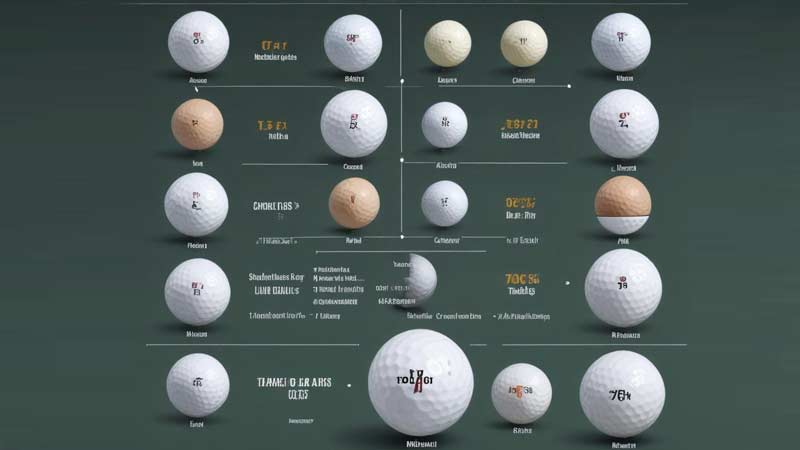Navigating the realm of golf ball compression is a pivotal aspect of tailoring your game to optimal performance.
The golf ball compression chart serves as a valuable guide, offering insights into the characteristics of different compression ratings and their impact on distance, feel, and control.
Understanding golf ball compression charts empowers golfers to make informed decisions based on their swing speeds, preferences, and skill levels.
In this dynamic landscape of golf ball technology, the compression chart stands as a roadmap, guiding players toward selecting the ideal ball that aligns with their unique playing styles.
What Is Golf Ball Compression?
Golf ball compression refers to the degree to which a golf ball deforms under pressure, specifically during impact with the clubface.
Measured in terms of compression rating, typically ranging from 40 to 100+, it indicates the ball’s ability to compress and then quickly regain its original shape.
Low compression balls (e.g., 40-70) are softer and compress more easily, suitable for slower swing speeds, providing more distance. High compression balls (e.g., 90-100+) are firmer, requiring higher swing speeds for optimal performance, offering better control.
Compression influences feel, distance, and playability, making it a critical factor for golfers to consider based on their swing characteristics and preferences.
Golf Ball Compression Chart

Here is a simplified golf ball compression chart with corresponding names and necessary descriptions
| Compression Rating | Golf Ball Type | Description |
| 40-70 | Low Compression | Softer balls that compress easily, ideal for slower swing speeds, providing more distance with a softer feel. |
| 70-80 | Mid-Low Compression | Balanced compression, suitable for a range of swing speeds, offering a combination of distance and feel. |
| 80-90 | Mid-High Compression | Versatile balls with a balanced compression level, providing a mix of distance and control for various swing speeds. |
| 90-100+ | High Compression | Firm balls requiring higher swing speeds, delivering enhanced control and reduced spin for players with faster swings. |
How To Know Which Golf Ball Compression Is Right For Me?
Selecting the right golf ball compression is crucial for optimizing your performance on the course. Factors such as swing speed, feel preferences, and overall game objectives play a role in determining the ideal compression rating.
Here are seven ways to help you identify the right golf ball compression for your game
Assess Your Swing Speed
Determine your average swing speed, as this is a key factor in choosing the right compression. Slower swing speeds typically benefit from low compression balls, while higher compression is suitable for faster swings.
Consider Your Skill Level
Novice golfers or those with a slower swing may find softer, low-compression balls more forgiving, providing additional distance. Advanced players with higher swing speeds might prefer the control offered by higher compression balls.
Evaluate Feel Preferences
Consider the feel you prefer during ball contact. Low compression balls offer a softer feel, while higher compression balls provide a firmer sensation. Experiment with different compression levels to find the texture that suits your playing style.
Analyze Spin and Control
Higher compression balls tend to have lower spin rates, providing better control. If you struggle with excessive spin, especially off the tee, a higher compression ball may help stabilize your shots.
Factor in Weather Conditions
Take into account the prevailing weather conditions in your playing environment. In colder temperatures, low compression balls may feel excessively soft, while higher compression balls can maintain their performance.
Test Various Brands and Models
Experiment with different brands and models across various compression ratings. Ball performance can vary, and personal preference plays a significant role in finding the right fit for your game.
Seek Professional Advice
Consult with golf professionals or experienced clubfitters who can analyze your swing and offer personalized recommendations. Their expertise can help you make informed decisions based on your unique playing characteristics.
Ultimately, finding the right golf ball compression involves a combination of self-assessment, experimentation, and perhaps professional guidance.
By considering factors like swing speed, skill level, and personal preferences, you can narrow down your choices and select a golf ball that enhances your overall performance and enjoyment on the golf course.
Conclusion
The golf ball compression chart is an indispensable tool for golfers seeking to enhance their performance on the course.
By deciphering the nuances of compression ratings and their associated characteristics, players can make strategic choices that complement their swing speeds and preferences.
Whether prioritizing distance, feel, or control, the compression chart serves as a valuable resource, allowing golfers to fine-tune their game and optimize their overall experience on the fairways and greens.
Embracing the insights offered by the compression chart is a key step towards achieving a more tailored and rewarding golfing journey.








Colin McCarthy